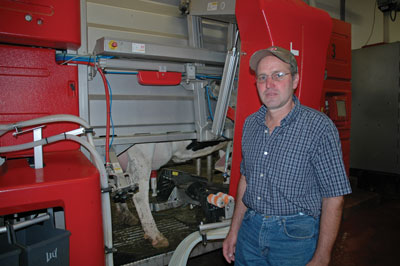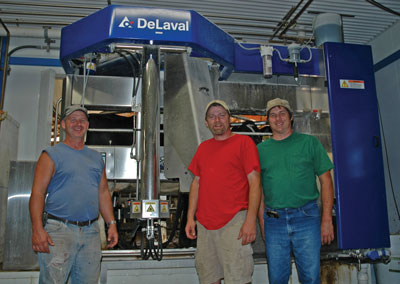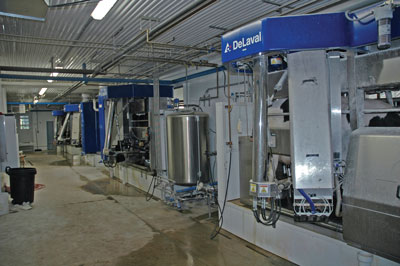Robot Economics

Can labor savings cash-flow robotic milkers?
 |
Tom Pfaff expanded his dairy to 420 cows and seven robots |
Bonus Content |
| More on robotic milkers: |
Even with a 20% volume discount, robotic milkers demand a pretty good milk flow in order to be able to cash-flow above and beyond conventional milk parlors. But as labor rates creep higher and labor availability becomes more uncertain, proponents says robotic milkers will slowly catch on. Perhaps.
The volume discount and labor savings make robotic milkers a better fit in herds with 300 to 500 cows than in smaller herds. That’s because robots in the larger facilities displace more labor.
“On a single-robot farm with 60 cows, there’s not much labor to replace. The owner still has to be there to manage it, so there’s no direct labor savings,” says Tom Anderson, a farm business instructor at Riverland Community College in Albert Lea, Minn.
When you run the numbers for interest, principal and maintenance, he says, you need to realize cost savings of about $33,000 per robot per year. With benefits added in, milkers can cost $12.50 to $14 per hour, according to Farm Credit System data. If they work 2,400 hours per year, that’s an actual cost of $30,000 to $34,000. The larger the installation, the larger the labor savings—to a point. A larger dairy might have to hire a herdsman to oversee the milking operation, but he’ll be managing the robots and not a labor force of six or more milkers.
That’s exactly what Tom Pfaff of Melrose, Wis., did when he built a 420-cow barn equipped with seven Lely robots. Prior to that, Pfaff was milking 160 cows 2X in a 60-cow tiestall barn with two employees and family labor.
Since moving to the new barn in November 2009, Pfaff hired a herdsman to manage the herd and the robots. With a conventional parlor, he figures he would have needed five to six additional employees to milk the expanded herd.
His existing workforce, plus the herdsman, can now handle almost triple the old herd size, feeding them and cropping a little more than 1,000 acres. At $179,000 per robot, it’s a true capital-for-labor exchange.
But it’s still a tight fit. Pfaff originally wanted to simply double his herd size to 300 cows or so. “But with just five robots, it was hard to justify the herdsman,” he says.
 |
Dugan Valley Dairy owners (left to right) Scott Kees and Dale and Larry Deetz did not hire additional labor when they built their 300-cow, five-robot barn. |
Even now, he figures he needs 80 lb. of milk per cow per day at $14.75 cwt. to cash-flow the system. And because he’s been in the facility only a year, he’s still not sure what his production will be. He hit 80 lb. per cow once (with 70% first-calf heifers), but then ran into some feed issues when the wrong mix was delivered to the bin.
The good news is that his somatic cell count has dropped below 200,000 cells/ml since moving to the new facility and has been as low as 140,000 cells/ml. That, plus component and volume premiums, means he usually claims a mailbox price $1 to $2 higher than Class III.
Pfaff’s lender, Brad Rommel of Jackson County Bank in Black River Falls, Wis., says he lent the money based on labor savings alone. “We were real conservative and took just the benefit of not having extra hired labor over the 10-year life of the robot,” he says. Even then, he budgeted only $20,000 to $25,000 per year per employee.
Dugan Valley Dairy, Mondovi, Wis., approached the problem from a different angle. Brothers Dale and Larry Deetz teamed up with their neighbor Scott Kees to build a 300-cow, five-
robot facility. The men kept their existing herds and built the dairy on a site suited for doubling. Neither of their old facilities, with 100 to 125 cows each, was expandable to more than 200 cows.
Scott and Larry manage the new facility, while Dale handles the feeding. Thus far, the trio has added no labor to manage the 300 mostly first-calf heifers in the new barn, milked by DeLaval robots.
 |
The barn is cross-ventilated with underfloor manure storage. One pen, on the west side, was designed as a compost pen for special-needs animals. But because these animals are also milked by robot and there are always cows lounging in the pen, Scott and Larry found it difficult to turn and till the compost every day. They are now converting most of that pen to freestalls, with alleys cleaned by scrapers that dump into the manure pit.
All the robots are housed in a central room that crosses the barn. Feed alleys line the outside walls. There are two pens of 120 cows in the eastern two-thirds of the barn, with each pen milked by two robots.
All this requires extra gating to allow cows to go to the robots and to the feedbunks separately. And all of that adds to the building’s cost.
The trio says the total cost of the facility—building, robots and manure storage—comes to $8,000 to $9,000 per cow. That hefty price tag requires a break-even of $16 per cwt.
“Farmers who take on these facilities have to be in a pretty good financial position,” says Dugan Valley’s lender, Steve Larson, assistant vice president with Badgerland Financial, Mondovi, Wis.
“These facilities take down equity because of the robots’ higher cost,” he says. “At the same time, the cost savings are there through less labor and fewer replacement cattle.” In Dugan Valley’s case, there is equity in land, and crop and steer sales backstopping the facility loan.
“The lending environment is certainly getting tougher,” Larson says. “It doesn’t matter if it’s a robot or a conventional parlor, any expansion will require more equity.”
In the past, borrowers with a good track record might have been able to dip below 40% equity after an expansion. No more. Lenders want at least 40% equity after an expansion, and some
require 50%.
Robots have another hill to climb. Lenders usually put a conventional parlor on the balance sheet at 80% to 85% of its purchase price. Robots often go on at 60%, simply because lenders don’t have a track record with them and are uncertain of how fast they will depreciate.
Some robot manufacturers offer lease options, which keeps the robot off the balance sheet. But that locks the lessee into the lease payment and eliminates the possibility of refinancing if interest rates decline.
Gaga Over Robots
The total number of robotic milkers worldwide is around 16,800, with 90% of them in Europe. The reason: labor cost. In Europe, the minimum wage is 9 euros per hour, or approximately $12 per hour.
But employers are required to pay twice that to cover benefits. “Employees work 47 weeks a year and have five weeks’ holiday,” says Wilfried Wesselink, Dairy Today’s European correspondent. “For any hours above 40 hours per week, the employer has to pay the employee plus 35%.”
In Holland, an employment service rents out workers to farms at about $20 per hour for a 17-year-old with no experience. Experienced workers make about $40 per hour. Immigrant labor from Poland and Hungary is billed at $20 per hour.
Also, these temporary wage rates don’t include Europe’s value-added tax, which in Holland is an additional 6% for agriculture.
It's All About Labor
Labor savings are the primary cash flow savings of robotic milking. “The savings are often more than three minutes per cow per day and can approach four minutes in some installations,” says Mark Futcher, marketing manager for Automatic Milking Systems for DeLaval Inc., North America.
That translates to anywhere from 1,100 hours to more than 1,400 hours of labor per robot per year. At $12.50 to $14 per hour when benefits are included, the range in savings is $14,000 to $20,000 per year. At the same time, “labor rates are likely to increase, while payments on the capital equipment will remain fixed for the length of the loan term,” Futcher says.
Other factors, such as less time away from feed and beds and more attention for individual cows, are tougher to quantify. With robots, the average milking time is seven minutes to seven and a half minutes. Even if cows spend time waiting to enter, they are away from feed and freestalls an hour per day at most. In conventional parlors, cows are often away from feed and freestalls at least one hour per milking, or two to three hours per day.
Robot efficiency is also improving. Ten years ago, a single robot harvested 4,000 lb. of milk per day. Today, that number is up to 5,500 lb. per day, with some operations achieving 6,000 lb. per day. The improvement comes from faster, more accurate attachment and milking and better cow management.
On the negative side, robots can be expensive to maintain.
Most facilities—whether they do all their own maintenance or only change liners—need to budget $3,000 to $6,000 per unit per year. Depreciation is another concern for new users and their lenders. But Futcher says the robots are robust.
“The first two units were installed on April 1, 2001, in North America, and they are still in operation,” he says. “They have been updated from air operation to hydraulics, but the basic units are still there.”
Editor’s note: Lely declined to comment for this story.







